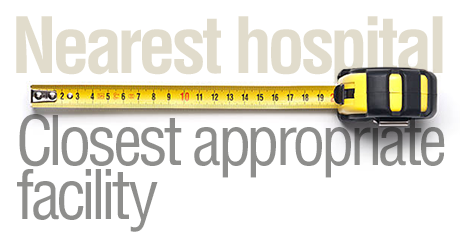New “Locality Rule”, New Problem
Let’s Review
If you’ve followed this space or have been connected to the EMS billing world for a fair amount of time, you should recognize the impact of the phrases “nearest hospital” and “closest appropriate facility.”
 Center for Medicare and Medicaid Services (CMS) rules for Medicare clearly stipulate that Medicare will only pay ambulance ground miles while the patient is loaded in the ambulance for transport and only the amount of miles that it takes to transport he patient to the nearest and closest appropriate facility.
Center for Medicare and Medicaid Services (CMS) rules for Medicare clearly stipulate that Medicare will only pay ambulance ground miles while the patient is loaded in the ambulance for transport and only the amount of miles that it takes to transport he patient to the nearest and closest appropriate facility.
However, the Medicare Administrative Contractors (MACs) have been allowed to process claims using what we refer to as the “locality rule”.
The “locality rule” allows for when patients normally seek medical attention at a few regional hospitals on a regular basis. The theory is the patient should be able to “shop around” for care and have a reasonable choice as a healthcare consumer to seek medical attention for the best value and even, in some cases, price.
So, if Hospital A is a bit more distant in miles than Hospital B, CMS/Medicare has approved payment for the additional miles to Hospital A because patients in that general geographical region seek medical attention at either facility on a regular basis.
What’s Changing?
This week, CMS released Transmittal 236 (Change Request 10110). This communication from CMS announced that beginning on September 18, 2017, the MACs will have the discretion to define “locality” in the various healthcare service areas that comprise the MACs jurisdictional territory (typically several contiguous States.)
We envision that the ambulance industry can expect the MACs to define many of these areas and the end result may be a deviation from how claims are currently processed.
For example, you may have long ago determined that your patient population regularly seeks treatment at any one of four facilities and have been billing full loaded mile totals and receiving Medicare reimbursement for those total miles.
Come September 18th, the MAC for your jurisdiction will have the ability to issue a communication that defines that only two of the four hospitals in your area will be considered to fit the “locality rule.” Now, instead of billing full loaded mileage totals when you transport a patient to one of the two that are no longer determined to be in “locality”, your billing office will be limited to billing the miles equal to the closest appropriate facility and the additional miles beyond that total will be required to be billed to the patient for out-of-pocket payment.
Thinking Ahead…
We brainstormed just some of the results of this change may look like and here are our thoughts…
- Cash flow changes- your EMS agency is used to a certain number of miles paid nice and neatly from Medicare and now a portion of those miles will not be immediately reimbursed.
- Patient liability portions will increase, causing a potential undue hardship for patients which will delay their satisfying the amount due to your EMS agency for the transport.
- Patient frustration will probably increase and we fear that instead of the blame going to CMS/Medicare it will be deflected to the EMS agency. Rest assured no one is going to understand this change or even be aware of it.
What can we do?
Prepare!
Run the numbers. Think about those facilities that potentially may fall outside of a newly and narrowly MAC-defined “locality” and project what the potential dollar hit to your organization may be and begin to have an alternative budget ready to go post-September 18.
Additionally, think about and begin preparing some public education and communication on the matter. Be prepared for how you and your staff and your billing office will communicate this change to patients so they understand why they now are receiving a bill for the same transport that, two months ago, Medicare paid for the entire trip.
Educate your staff, too. Be sure they understand what’s coming. Our friends at Page, Wolfberg and Worth mentioned that EMS agencies may wish to increase the use of the Advance Beneficiary Notice of Non-Coverage (ABN) to inform your patients, up front, that they will have financial liability beyond what Medicare pays. Be sure the staff understands how to present the and explain the ABN in the field.
Finally, educate the facilities you serve as they may be able to help you spread the word about what may be changing too.